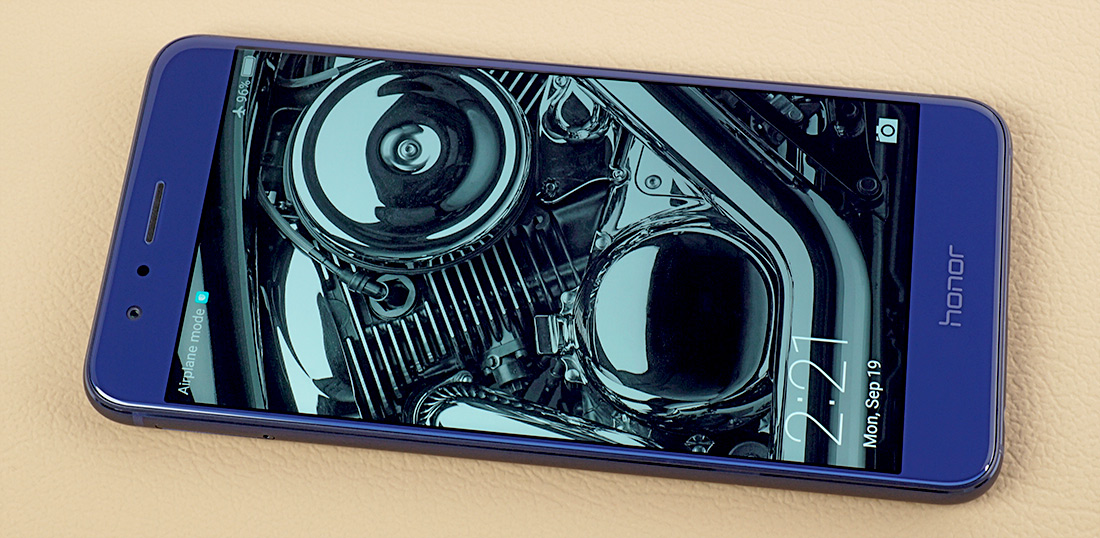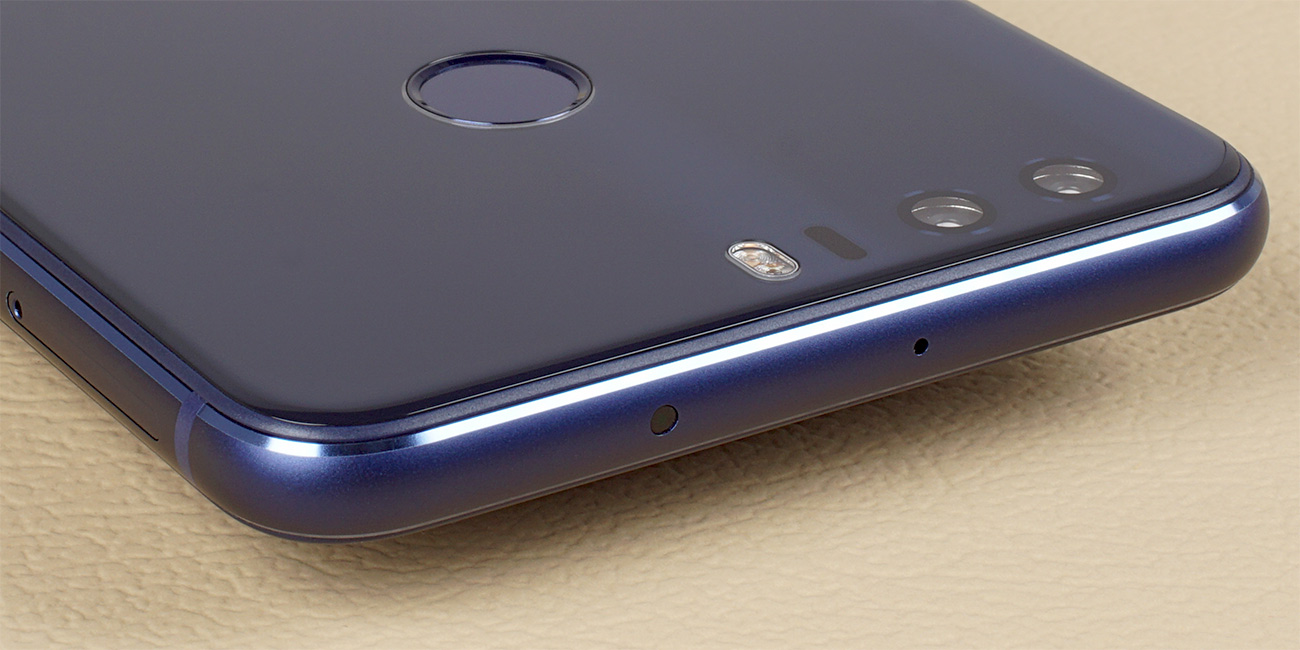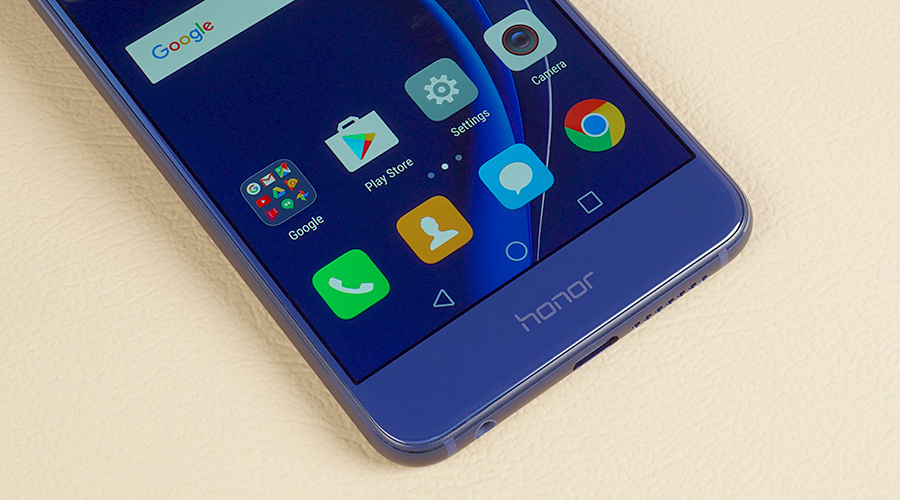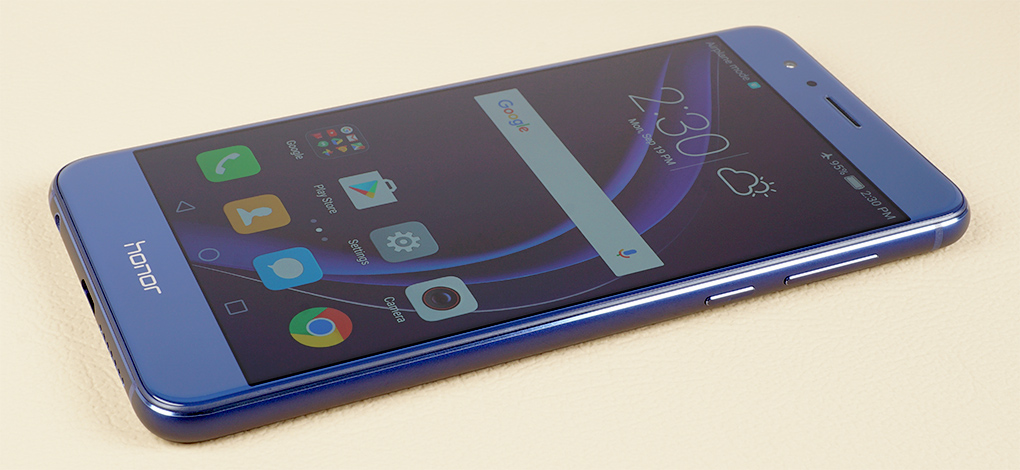The Huawei Honor 8 Review
by Matt Humrick on October 13, 2016 8:00 AM EST- Posted in
- Huawei
- Smartphones
- Mobile
- Kirin 950
- honor
Final Words
Just like it did with the Honor 5X, Huawei has done a good job finding the right balance between features, performance, and price for the Honor 8. It’s not perfect (I’ve yet to see a phone that is), but it shows a level of polish that other phones at this price and below lack. In a way, the Honor 8 is sort of a sleeper. Sitting among the nearly two dozen phones currently on my desk, the Honor 8 does not really stand out, but if I were to arrange them in a stack from least likely to most likely to use, I would put it near but not at the top.
This polish is most evident in its design and build quality. The Honor 8 looks and feels like a premium phone, with nicely chamfered edges, flush cameras, shimmering surfaces, and rounded corners. The ergonomics are good too: The rear-mounted fingerprint sensor and power/volume buttons are within easy reach, but sit high enough to avoid accidental presses.
Personally, I would prefer to see metal rather than glass on the back, however. Glass attracts more fingerprints, is more likely to slide from your hand or off a table, and is less durable if dropped. This last point is especially relevant for the Honor 8 because the rear glass also covers the camera lenses. If the glass cracks in the upper-left corner from a drop, it could render the rear camera unusable. Most of these issues go away if you slip it into a case, though.
The Cortex-A72 CPUs, 3-4GB of LPDDR4 RAM, and Huawei’s under-the-hood software tweaks combine to make the Honor 8 feel plenty fast. It performs common tasks, including opening and switching between apps and browsing the web, as fast or faster than some flagship phones, and it remains fluid while scrolling and during other UI interactions. There’s still some jank in third-party apps, but this has more to do with poor app design than the phone itself.
While its Mali-T880MP4 GPU supports the latest graphics APIs and is capable of playing most modern Android games, the Honor 8 is not really a phone for gamers. The four core GPU configuration severely limits peak performance to the point where it could struggle with some titles.
The Honor 8’s battery is not particularly large, and with its high level of performance, battery life is a natural concern. Our tests, however, show that its battery life is no worse than similarly sized competitors such as the Samsung Galaxy S7; it even outlasts the current flagships in our web browsing battery test. With 8 hours of screen on time in PCMark’s battery test, the Honor 8 should have no trouble lasting an entire day on a single charge for most users.
The dual rear camera takes some very nice photos and even decent video, but it’s not good enough to beat out the single cameras belonging to some of the current flagship phones such as the Galaxy S7, at least not in all scenarios. It does well with exposure and white balance in general, and during the day or in good lighting it captures a lot detail with very little noise. Low-light performance is not quite as good, often producing blurry images when the autofocus system fails to acquire a target. This can usually be mitigated by tapping to focus, but there’s no solution for its poor HDR performance.
The rear camera’s simulated wide aperture feature is a nice bonus. It uses the dual rear cameras to capture a depth map that allows you to create some very nice looking simulated bokeh effects. It even allows you to change the object in focus and the amount of blur after the image is taken. The feature works well and is a definite value add for people who enjoy taking creative photos.
The one area where the Honor 8 really falls short is the display. It uses a quality panel that delivers a respectable peak brightness and a good black level, but Huawei does a really poor job with calibration. The overly cool white point and RGB imbalance leads to poor grayscale performance and a screen with an obvious blue or turquoise tint. It’s possible to adjust the Honor 8’s white point, but it does not fully fix the grayscale issue and just makes the problem worse in most cases. Its use of a wide color gamut panel also leads to inaccurate, oversaturated colors. People who prefer more vivid colors probably will not mind, but those who prefer color accuracy will be disappointed that there’s no sRGB mode. Beyond the grayscale and color issues, the panel on our Honor 8 shows a red-tinted sheen and reduction in brightness when viewing the screen tilted at even a small angle or slightly off center that does not occur with most IPS displays.
The Honor 8 finds itself in an interesting position. In the US market, there’s quite a few phones to choose from at the high end and the low end, but good phones in the middle are difficult to find. The OnePlus 3 and Moto Z Play both cost about the same as the Honor 8, have better displays, and competitive cameras, but are larger 5.5-inch phones that may turn some people off. If you’re looking for something a bit smaller that costs less than the HTC 10 or Galaxy S7, but still want a polished user experience, the Honor 8 is a pretty good phone that’s worth a look.















95 Comments
View All Comments
Matt Humrick - Friday, October 14, 2016 - link
That's a good point. The Smart mode selectively reduces screen brightness when using specific apps. It does not alter screen brightness for the PCMark test, which is one reason why there is not a bigger gap between it and the Performance mode; however, it does drop brightness from the calibrated 200 nits to about 100 nits when using the Chrome browser, which would increase the battery life in our web browsing battery life tests (these were run in Performance mode).prku - Friday, October 14, 2016 - link
Honor 8 is not a dual-standby dual sim phone. Please check again. it is supposed to have Dual Sim Full Active (which is a major selling point). DSFA is supposed to be present in all but Indian variations of the Honor.randomlm - Saturday, October 15, 2016 - link
Thanks for the nicely written, well balanced and non-biased review matt. This is the standard I've come to expect from anandtech that imo, some other reviewer on this site hasn't been delivering, especially on the camera portion of the review.Of course, entirely just my opinion
Feegenie - Saturday, October 15, 2016 - link
Fair.........jvl - Saturday, October 15, 2016 - link
"It’s a bit unfair to point our fingers solely at the OEMs and carriers, of course, because it was Google that created this mess and, ultimately, only Google can clean it up."What.
lagittaja - Saturday, October 29, 2016 - link
Do you even Android? Version distribution. Google can't force OEM's or carriers to update the devices.Even Android N's "auto update" doesn't really fix anything.
Why would the carrier or OEM keep updating the devices if they can just drag their feet on the ground making the update process as slow and painful as possible or just flat out not update them? Even once? The consumer will just buy a new device anyway.
Between 29th Aug and 5th Sept, of all the devices "phoning home" to Google a whopping 81.3% were running Android Lollipop 5.1 or older version.
If you take Lollipop out of the equation, 46.3% of the devices were running KitKat 4.4 or older.
If you take KitKat out of the equation, still almost 20% of the devices were running Jelly Bean 4.3 or older..
https://developer.android.com/about/dashboards/ind...
http://www.infoworld.com/article/3072591/android/g...
Google even tried to downplay the issue during May I/O event saying "it's not fragmented".
https://data.apteligent.com/download-report?report...
Yeah, that looks SO much better... 80%+ of devices being used are running Lollipop or older. A third of the devices being used are running KitKat or older..
And saying yeah, well only KitKat, Lollipop and Marshmallow matter because reasons and hey look at that 92% of devices being "used" are running Android OS's that "matter" and oh hey in contrast to iOS there's only iOS8 and iOS9 that matter and oh hey that comprises 97% of the iOS traffic. We're just as good as Apple! Yey us!
Uhm no.. Apple keeps it tidy because they have CONTROL...
iOS 9 only runs on devices that are from 2011 or older.
iOS 10 only runs on devices that are from 2012 or older.
Google has no control what so ever of Android devices that are not made by them.
Bloody hell, there's still Android devices sold new that run KitKat. And guess what, most of them are not going to receive a single damng update because the OEM doesn't give a flying fuck about it.
Look at Apple, look at what devices they sell. Guess what, they run iOS 10 or are just waiting to be turned on so they can nag you that there's a pending update.
With Android Nougat Google should have grabbed the "bull by the horns" and just fix the God damn problem.
They should have made a way for them to be able to at least deliver the critical security updates to the devices "automagically" no matter what sort of customizations OEM's or carriers have done.
I don't have the faintest idea of how that could be done but it's the least that needs to be done.
P.S. I'm an Android user and always will be. I don't like Apple's devices or their OS but I like how good control they have over their devices.
phuzi0n - Sunday, October 16, 2016 - link
Is this a phone review or a car review? We could do without all the car analogies in the first three paragraphs.Badelhas - Sunday, October 16, 2016 - link
I hate these Chinese UI skins which are iPhone iOS imitations. But that's just me.nkuehn - Friday, October 21, 2016 - link
Matt, did you also do testing on the Cellular Performance? Anandtech is famously good at really testing and not just testin, but I'm totally missing this part. I'm asking because some other reviewers had serious issues with the LTE performance of the device, losing LTE connection in well covered area etc.Maybe partner with people like http://cellularinsights.com/ - they have the testing hardware for cell that you have for displays and all the other stuff.
Savanah - Thursday, October 27, 2016 - link
I am so glad I went for the Moto Z Play instead of the Oneplus 3. It has a premium build quality, great display, awesome battery life, buttery smooth performance and decent cameras. It also excels in areas we tend to take for granted like call quality and signal retention. And to top it off it is bound to get fastest Android updates of any non Nexus/Pixel device. What else can you wish for in a $350 smart phone?